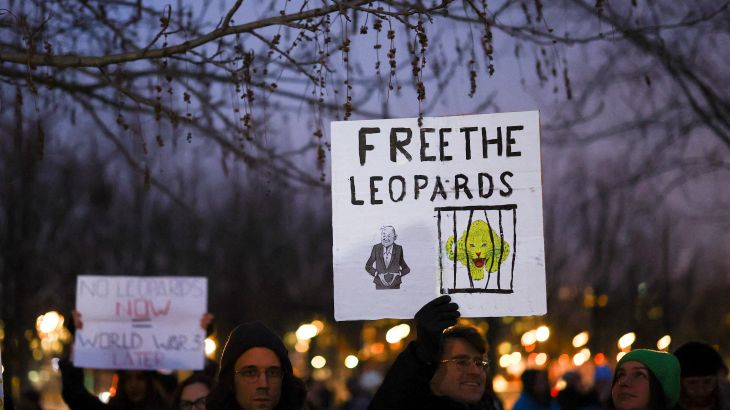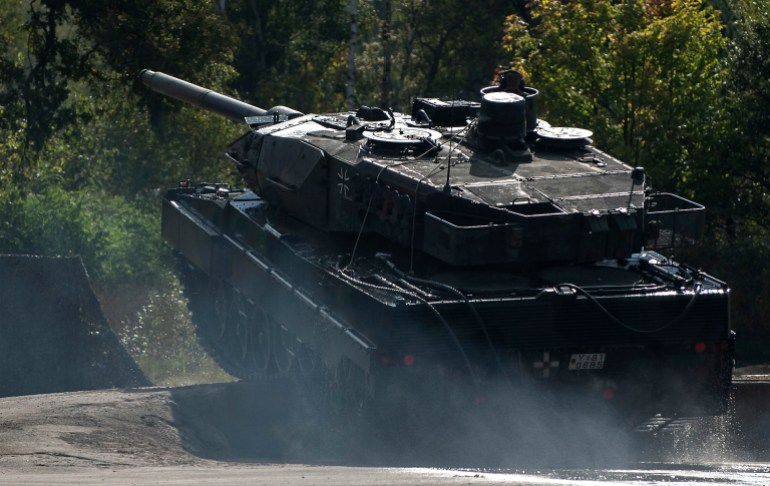‘Rather pathetic’: Germany feels the heat after tank resistance
Germany held off on sending prized Leopard 2 tanks to assist Ukraine’s upcoming offensive, until the US also provided Abrams tanks.

It took time, threats and plenty of embarrassment but in the 48th week of the war Germany joined its allies in pledging its prized battle tank to Ukraine to fight the Russians.
German Chancellor Olaf Scholz on Wednesday announced Berlin will send a company – about 14 – of the Leopards to Kyiv, and allow other countries owning them to do the same.
Keep reading
list of 4 itemsRussian playwright and director go on trial over ‘justifying terrorism’
Russian court hands 25 years to arson plotter accused of Ukraine links
Russia-Ukraine war: List of key events, day 816
The tanks are meant to help Ukraine mount a new counteroffensive, or rebuff a renewed Russian offensive – whichever comes first.
“Spring and early summer [March-August in Europe] will be decisive in the war. If the big offensive of Russia planned for this time fails, it will be the downfall of Russia and Putin,” said Ukraine’s deputy military intelligence chief Major-General Vadym Skibitskyi.
Even though the number of tanks is far short of what Ukraine requested, Germany consented only after days of pressure from its allies who made it clear Berlin was isolated on the matter.
Western governments have generally been careful not to escalate the conflict by providing weapons only as needed.

On January 14, the United Kingdom broke the taboo on heavy armour, saying it would send a company of its Challenger 2 tanks to Ukraine.
UK Prime Minister Rishi Sunak encouraged other allies to send help. The pressure for tanks fell on Germany because the Leopard is the most mass-produced battle tank in Europe, with some 2,000 spread across 13 countries.
But Germany refused to either to send its own tanks, or license others to re-export theirs – a necessary legal step.
“Germany does not want to be singled out as the country that has sent the heaviest assault weapons to fight the Russians. This will certainly play into a narrative of a second German invasion into Russia,” said George Pagoulatos, director of the Hellenic Foundation of European and Foreign Policy, a think tank in Athens, referring to the Nazi invasion of Russia during World War II.
In part, though, it was the German chancellor’s own governing style that was to blame, said Minna Alander, research fellow at the Finnish Institute on International Relations.
“There seems to be this problem that Scholz listens only to his circle of long-term advisers, and in their own echo chamber, it seems they have decided this is the right way – being level-headed, sober-minded, not letting yourself be pushed into anything,” Alander told Al Jazeera.
Germany confirms it will supply Ukraine with Leopard 2 battle tanks and approve requests by other countries to do the same.
🟠 LIVE updates: https://t.co/f8ew4EPuU8 pic.twitter.com/UeetSYxMrQ
— Al Jazeera English (@AJEnglish) January 25, 2023
Excuses, excuses
Some of Germany’s arguments came across as desperate. At a meeting of the Contact Group on Ukraine in the German city of Ramstein last week, where 50 countries gathered to pledge military aid, German defence minister Boris Pistorius told incredulous allies that he had just ordered an inventory of Leopard stocks to gauge their availability.
Business Insider reported his predecessor, Christine Lambrecht, had forbidden such an audit, fearing the mere existence of the document would put pressure on chancellor Scholz to act.
But a Spiegel report revealed that inventory of Leopards in the Bundeswehr had been taken in mid-2022, showing at least 19 tanks were immediately available for Ukraine.
In addition, German defence contractor Rheinmetall said it could furnish 88 older Leopard 1 tanks in April 2022, a month after Ukraine requested them, and this week Rheinmetall said it could additionally supply 29 newer Leopard 2A4 tanks by April.
Ukraine started the war with about 900 battle tanks, according to a RUSI report, but has suffered attrition and now needs hundreds, rather than dozens, of replacements.
In an interview with the Economist in December, Ukraine’s top general, Valerii Zaluzhny said he needed 300 tanks, 600-700 infantry fighting vehicles, and 500 howitzers to help his forces push back Russian forces.
European Council President Charles Michel told Ukraine’s parliament he supported longer-range weapons and tanks from the West.
“You need more. More air defence systems, more long-range missiles and ammunition and, most of all, you need tanks. Right now,” Michel said.
Germany’s problems complicate Ukraine’s fight
Germany has suffered economic damage from the war, said Pagoulatos.
“German industrial competitiveness, based on cheap energy imports from Russia and good economic relations with Russia, has … been dealt a terrible blow,” he told Al Jazeera.
But the country has also lost a political leadership role in northeastern Europe, whose EU accession it championed and whose economies it helped develop, said Pagoulatos.
“This is pretty self-destructive for Germany because it ends up doing what other Europeans are asking it to do … but doing it too late and after being beaten up in the public debate,” Pagoulatos said.
After Ramstein, the three Baltic countries’ foreign ministers called on Germany immediately to send tanks to Ukraine – a sign of how far Germany’s standing in Europe has fallen.
Poland’s foreign minister Mateusz Morawiecki said he might ignore German re-export licenses and send tanks to Ukraine anyway.
“Consent is of secondary importance here, we will either obtain this consent quickly or we will do what is needed ourselves,” he said.
A week earlier, Poland’s President Andrzej Duda said he planned to build a coalition of those willing to send Leopard tanks to Ukraine – effectively usurping Germany’s role.
Observers saw venal motives at work. German lawmakers were “giving strategic priority to the long-term relationship with Russia”, wrote Oxford University historian Timothy Garton Ash.
St Andrews strategy professor Phillips O’Brien called it “a rather pathetic desire to stay in Russian favour for the post-war world”.
Germany may have stuck to its guns at Ramstein, but its resistance unraveled over the weekend, as the Green Party, a junior partner in the governing coalition, distanced itself from Scholz’s Social Democrats.
Foreign minister Annalena Baerbock told France’s TV1 that Germany “wouldn’t stand in the way” of other countries sending their Leopard tanks, contradicting Pistorius’ remarks at Ramstein that such requests would have to go through lengthy procedures.
Germany had argued at Ramstein it could send one Leopard for every Abrams battle tank sent by the US. Military experts have argued the Abrams is more expensive to run and more difficult to train on.
“This seems to have been an original Scholz idea,” said Alander. “The reasoning is it’s a fair deal because Germany depends on the US nuclear umbrella and Germany is much closer to the fight.”
The US administration of Joe Biden approved 31 Abrams tanks for Ukraine on Wednesday. But now the Ukrainian army will have to train on three new battle tank designs – the British Challenger, the German Leopard and American Abrams – all in order to reassure Germany it will not suffer from excessive Russian criticism.
Momentum to send Ukraine heavy armour began to build in the second half of last year, after it became clear that Ukraine’s armed forces needed it to follow through on their successful counteroffensives in Kherson and Kharkiv – if they were to break through Russian entrenched positions.
The European Council on Foreign Relations suggested sending Ukraine 90 tanks, with the EU paying to replace older 2A4 and 2A5 models sent to Ukraine with newer 2A7s. This modernisation could in turn spur Germany to rebuild its largely dishevelled Bundeswehr.

Weapons are flowing to Ukraine
Ukraine also won other significant pledges during the past week.
On the eve of the Ramstein meeting, nine EU members met at Tallinn, the Estonian capital, to pledge an “unprecedented set of donations” to Ukraine.
“We commit to collectively pursuing delivery of an unprecedented set of donations including main battle tanks, heavy artillery, air defence, ammunition, and infantry fighting vehicles to Ukraine’s defence,” the countries said in what has been called the Tallinn Declaration.
Poland said it would give Ukraine more Soviet T-72 tanks and 42 BMP-1 infantry fighting vehicles by March, as well as step up training.
Denmark said it would send Ukraine 19 self-propelled Cesar howitzers, infantry fighting vehicles, and the Archer artillery system, among others.
Sweden earlier announced a $419m package of weapons. The UK would send 600 anti-tank Brimstone missiles.
The US pledged a $2.5bn drawdown of weapons including plentiful ammunition, 59 Bradley Fighting Vehicles in addition to the 50 pledged, and 90 Stryker APCs.
‘Throwing soldiers like cannonballs’
Ukraine will likely need all it can get. Its troops fought fiercely to retake Novoselivske in Luhansk on January 19, and were awaiting reinforcements to press onto neighbouring Kuzemivka. The Ukrainian advance seemed like an attempt to create a salient north of Svatove, from which to encircle the Russian-occupied city.
But further south, in Donetsk region, Russian forces pressed forward around Bakhmut, capturing the towns of Soledar and Klishchiivka and threatening lines of communication.
“The fall of Bakhmut would have consequences for the entire line of Ukrainian defence. They say that Russia is now throwing soldiers like cannonballs since the losses there do not bother it,” Spiegel quoted a German intelligence report as saying.
Ukraine has less manpower to draw on than Russia in these attritional battles. The Ukrainian army is losing a three-digit number of soldiers every day, Germany’s BND intelligence service told a group of Bundestag lawmakers at a secret meeting last week – a reminder that delays in arms delivery are measured in lives lost.